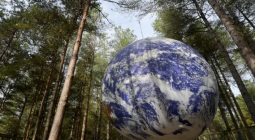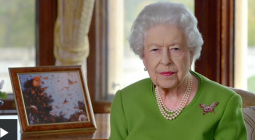Class action: children around the world get a lesson in peanut butter and turtles

A livestreamed session at Cop26 sets out to educate and inspire tomorrow’s leaders, from Ukraine to Peru
“Type your favourite crunchiness of peanut butter into the chat thread,” says Matthew Shribman to a global classroom of children, as the scientist and teacher kicks off the Great Big Lesson for Nature at Cop26 in Glasgow.
Thousands of schoolchildren from across the world have joined the virtual lesson broadcast live from the nature pavilion in the blue zone, right next to where world leaders make decisions that affect these young people’s future.
At the classroom entrance, a sign reads: “Chairs have been fashioned for kings and queens and leaders for millennia. The chairs you are sitting on today have been used by schoolchildren. It’s time to put yourself in their shoes – as well as their seats.”
Four thousand schools from countries including the UK, Ukraine, Brazil and Peru, registered for the one-hour lesson broadcast on YouTube. It is hosted by AimHi Earth, a climate education organisation, and backed by the Potsdam Institute in Germany and Cambridge University in England. Educators from India, Peru, Malaysia, Indonesia and Qatar all contribute to the lesson, which is delivered in partnership with World’s Largest Lesson, Nature4Climate and Youthtopia.
There are the usual glitches – the internet drops out, teachers forget they are on mute – but it doesn’t stop the message getting across. Shribman, the lead teacher, says: “I think it’s really important we’re making rock stars out of these young change makers, getting them in front of thousands of people telling the truth in a way that is engaging and powerful. To have these people from around the world teaching young people through this stage of Cop26 is so powerful.”

After the peanut butter ice-breaker question, the young crowd discuss a range of environmental issues including how the sex of sea turtles is determined by heat – the hotter the temperatures, the more likely they are to be female; in some parts of the world the ratio of male to female turtles is one to 100. Teachers talk about geoengineering, carbon capture and storage, “sponge cities”, what healthy soils look like, as well as offsetting and why we should eat less meat.
Friday’s youth day event is for young people over the age of 11. “It’s amazing to think of hundreds of thousands of kids watching this live from Cop26,” says Sarah Humphrys, co-founder of AimHi Earth. “It’s about us bringing the conversation to them. The blue zone feels very exclusive, especially for young people, so this was a chance to bring them into this space.”
The team also runs adult classes, and has been working with members from the UK’s House of Lords. “The response has been fantastic. It has enabled people to link these ideas together. People at the top of the leadership don’t understand the crisis, through no fault of their own. It’s because the education system is not giving people the information they need,” says Shribman.
Organisers hope that the population will be better able to drive change if they understand the issues, and they are campaigning for more education on the environment in schools. The government is considering whether to introduce a GCSE in natural history.
“Cop26 is sadly not a meeting of people coming together to try to work to stop the climate and nature crisis,” says Shribman. “It’s a meeting of people coming together trying to hold on to as much as they possibly can. And in some ways there are many inspiring people here doing all they can to build a healthy, more verdant future that we all want, but there is a lot of work to do while leaders still make selfish decisions.”
The online lesson focuses on nature, because Shribman believes it is at the centre of the climate crisis. “The scariest thing about Cop26 is that people think we can control the climate crisis just thinking about carbon. Imagine the world we will get to if that’s all we think about? There will be no nature, and the world will be an unhealthy place, but at least we’ve got to net zero,” he says.
6 November 2021
The Guardian







